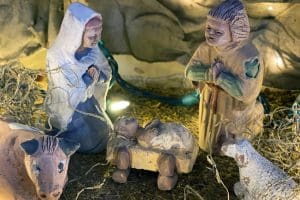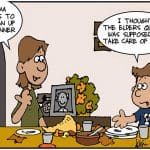![]()
Creation of a Masterpiece
by Robb Cundick
On April 13th and 14th in the Salt Lake Tabernacle, the Mormon Tabernacle Choir and Orchestra at Temple Square will celebrate Easter by performing a unique musical work, The Redeemer. While not widely known, it has been quietly enfolding the hearts of all partakers since 1978.
This is the story of a masterpiece, a life’s work; the culmination of training and experience in a single creation of transcendent beauty. I cannot claim to be objective in the telling, but will write with feeling and reverence. For this work was brought to pass by one of the people I love most – my father, Robert Cundick, Tabernacle Organist Emeritus; a man whose name I share. The Redeemer, a sacred musical work, is his masterpiece.
Each of us, at some time in life, should create a masterpiece; something that represents the very best we can give to our world. Perhaps the first thing that comes to mind when we think of a masterpiece is a work of art – a painting, a piece of music, a play or a book. But it may not be an object easily defined. Perhaps it is our most selfless act or greatest gift of love. It could be a heroic deed or something more than meets the eye – such as a finely developed talent or skill that blesses the lives of those around us. When we reach such a pinnacle it is doubtful that we arrive there alone – we need only glance over our shoulder to see that the Lord is our close companion.

Robert Cundick
Though my father’s name is most familiar for its frequent mention at past General Conferences, Dad is first and most a composer and arranger of beautiful music. Ralph Woodward, former Professor of Music and Choral Director at BYU, knew this. In 1977 he had a dream:
“The idea, the dream for a composition such as The Redeemer, was to create a sacred work of genuine stature that would have meaning not only to the Latter-day Saints but to Christians of every religious persuasion. .In early 1977 I approached .[the] chair of the BYU Department of Music, and he quickly approved the idea and my recommendation of Robert Cundick as composer. Cundick eagerly accepted, and we quickly went ahead with performance plans for the next year’s Easter season.”
But my Mother’s journal reveals the initial process as being a little more tentative. One doesn’t always know when it’s time to create a life’s work. Mom records that Brother Woodward’s first approach came a year earlier. Dad asked a close friend to write a text, but was disappointed when Ralph decided it wasn’t what he had in mind. The project was postponed a year; Brother Woodward would provide a text. Dad went on with his busy career and forgot the whole thing.
In April of 1977 a package arrived from Brother Woodward. He had carefully combed the Standard Works for the most important references to the Savior’s mission on earth. The package contained a folder of them. Dad looked it over, but having more pressing concerns, he placed it on a closet shelf. In August he met Ralph at a BYU Faculty Meeting. When asked how the composition was coming he confessed he had not given it a thought until that moment. Ralph was taken aback and the project was nearly abandoned then and there. But Dad wanted to give it a try. Ambitious deadlines were set and he went right to work. Quoting from Mom’s journal:
“By the end of two days he had put the words together and had the lyrics ready. He was so impressed with these scriptures and how beautifully they fit together. He could take one from the Book of Mormon and put it with one from the Bible and they fit like a glove.”
Indeed, selections from the Bible, Book of Mormon, Doctrine and Covenants, and Pearl of Great Price are interwoven in what Brother Woodward later called, “one musical testament of faith.” He said, “One of the rich blessings of my life was the privilege of choosing those scriptures.”
But setting the scriptures to music presented a special challenge because there is no meter. When he sat down to the piano, Dad asked himself how he could accomplish this. It did not take long to realize that the solution should come from the scriptures’ very source:
“He went in the bedroom and knelt down and prayed. When he was through he went back to the piano and immediately began to write. What an experience! As long as he prayed before he began, the notes came almost as fast as he could write. If he forgot to pray first he soon remembered because nothing came. As he completed a piece he would play it for Ralph, who became increasingly excited as more was finished. Over and over Bob expressed the desire to write music worthy of the beautiful scriptures he was setting. He finished the composing a few days before the deadline, feeling amazed because it had come faster than he had ever composed before. It just flowed!”
Never had heaven felt so near than during this remarkable 10-week period. But the work was not yet complete, for it had to be orchestrated as well. Again, time was of the essence:
“He immediately began the orchestration. He had worried more about orchestrating than anything. He had asked [a friend] for some suggestions but [the friend] didn’t get around to it so he just dove in and began. It went very well. It took every second of his time. He was up early each day and worked late each night, yet he never had a sick day through it all – the first year in our married life he hadn’t had so much as a cold!”
Ralph Woodward was not the only one who marveled at how quickly this beautiful music came into being. I was living in the basement with my young family at the time and can remember days when the most beautiful chords I have ever heard came drifting from above (it now seems so fitting – that impression of chords from above). Jerold Ottley, John Longhurst and other associates of the Tabernacle Choir Staff provided advice and support. They, too, recall it as a spiritually rewarding time for all who were fortunate enough to witness and participate in it.
BYU Choirs and Orchestra premiered the work in 1978; details from Mom’s journal:
“The impact of the performance on those who attended was amazing and difficult to describe. Surely it filled Bob’s greatest hope – that it would draw people closer to the Savior. After the first performance everyone waited while President Kimball’s party left. As we got outside the auditorium Elder [Boyd K.] Packer moved over to Bob and tried to say something but couldn’t get a word out. He just threw his arms around him and embraced him.”
Listening to a tape of that performance, one can hear the quiet weeping of choir and audience during the orchestral postlude. It has been so for me every time I have heard it. The last performance I witnessed was by a Stake choir and orchestra. Clayne Robison, of BYU, conducted. He has a great love for the work and has frequently sung the role of the Savior. I wondered how it would come across, since to perform music of such sweeping scope usually requires well-trained musicians. But they performed with great feeling, and I rejoiced in the discovery that the experience was as moving as ever.
The Redeemer is best heard while reading along with a copy of its scriptural text. What makes a live performance unique is that it is not presented as a concert, but rather a worship service. Dad has a vision of the ideal Church of Jesus Christ Worship Service. The congregation would enter quietly during the prelude music, then sit and contemplate while enjoying the beautiful music. The same procedure would be repeated after the meeting as we reflected upon what we had learned. People would leave the chapel silently. (Well – maybe it would work if we didn’t have children and we weren’t so darned friendly!)
Thus, The Redeemer is subtitled, A Sacred Service of Music. It is to be performed from beginning to end without interruption – no applause and no intermission. A beautiful orchestral prelude, “the Savior’s theme” precedes an opening prayer. Then comes the body of the work, divided into three sections – The Prophecy, The Sacrifice, and The Promise. Following a closing prayer comes the postlude. The same sacred musical phrase is used both to begin and to end the work – representing Alpha and Omega.
I have always been struck by the absence of the kind of boisterous ending usually associated with such an oratorio. The final number, “He is the Root and the Offspring of David,” is glorious, but it ends softly with the words, “Surely, I come quickly. Even so, come, Lord Jesus.” It leaves me with a desire for more – a feeling I believe we should always cultivate in our hearts – that desire for more of the Savior’s closeness and hope for his return.
Words are inadequate to describe the effect The Redeemer has had upon my life. It has been a source of comfort, light and inspiration in times of trial. Once you’ve listened enough to let it sink into your soul, its scriptures will ever be highlighted with beautiful music when you come across them in your readings. Many times I have found tears welling in my eyes when one of them happens to surface in a talk or Sunday School lesson. I feel like raising my hand to interrupt and say, “Wait a minute! You’re only telling half the story. If you could only hear it sung with beautiful music that brings it to life and inscribes it upon your heart!”
I have always told people that Dad considers The Redeemer to be his life’s work. But the assumption was mine, given the fact that since its creation he has steadfastly refused all requests to compose a work of similar magnitude. Before reiterating it here, I gave Dad a call to be sure it is accurate. His response? “Oh, yes. It is the one really significant thing I have contributed to the world.” “Why have you turned down other requests?” I asked. “Because it was a one time flash of inspiration. I don’t think I could do it again.”
At the top of the title page is this phrase: Soli Deo Gloria. To God Alone Be the Glory. And so it should be. Because all that we are and ever hope to be we owe to our Heavenly Father and His son Jesus Christ. Ultimately, they are the creators of all masterpieces.
Free tickets for the April performances (the 13th and 14th at 7:30 PM in the Tabernacle) are available at the Conference Center ticket office. But don’t be discouraged if you can’t get them. Come early and wait in the standby line! There are almost always seats available.
For those too far away, BYU has a web page highlighting their 1996 recording of the work. Included is the scriptural text as well as a short sound clip montage. See: https://advance.byu.edu/redeemer/redeemer.html
2001 Meridian Magazine. All Rights Reserved.

















